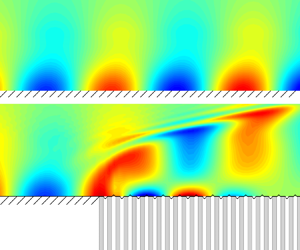Refine listing
Actions for selected content:
1419516 results in Open Access
CJN volume 50 issue 6 Cover and Front matter
-
- Journal:
- Canadian Journal of Neurological Sciences / Volume 50 / Issue 6 / November 2023
- Published online by Cambridge University Press:
- 23 October 2023, pp. f1-f5
-
- Article
-
- You have access
- Export citation
Employer-provided childcare across the 50 United States: the normative importance of public childcare and female leadership
-
- Journal:
- Journal of Social Policy / Volume 54 / Issue 2 / April 2025
- Published online by Cambridge University Press:
- 23 October 2023, pp. 574-594
- Print publication:
- April 2025
-
- Article
-
- You have access
- Open access
- HTML
- Export citation
Internal shear layers in librating spherical shells: the case of attractors
-
- Journal:
- Journal of Fluid Mechanics / Volume 974 / 10 November 2023
- Published online by Cambridge University Press:
- 23 October 2023, A3
-
- Article
- Export citation
Some measure rigidity and equidistribution results for β-maps
- Part of
-
- Journal:
- Ergodic Theory and Dynamical Systems / Volume 44 / Issue 9 / September 2024
- Published online by Cambridge University Press:
- 23 October 2023, pp. 2581-2598
- Print publication:
- September 2024
-
- Article
- Export citation
Does the Best System Need the Past Hypothesis?
-
- Journal:
- Philosophy of Science / Volume 91 / Issue 2 / April 2024
- Published online by Cambridge University Press:
- 23 October 2023, pp. 410-429
- Print publication:
- April 2024
-
- Article
-
- You have access
- Open access
- HTML
- Export citation
Normal families and quasiregular mappings
- Part of
-
- Journal:
- Proceedings of the Edinburgh Mathematical Society / Volume 67 / Issue 1 / February 2024
- Published online by Cambridge University Press:
- 23 October 2023, pp. 79-112
-
- Article
- Export citation
Initial and 5-day positivity rate of severe acute respiratory coronavirus virus 2 (SARS-CoV-2) polymerase chain reaction (PCR) in exposed inpatients within shared rooms during the omicron-variant dominant period
-
- Journal:
- Infection Control & Hospital Epidemiology / Volume 45 / Issue 3 / March 2024
- Published online by Cambridge University Press:
- 23 October 2023, pp. 377-379
- Print publication:
- March 2024
-
- Article
- Export citation
How the Trump Administration’s Quota Policy Transformed Immigration Judging
-
- Journal:
- American Political Science Review / Volume 118 / Issue 4 / November 2024
- Published online by Cambridge University Press:
- 23 October 2023, pp. 1688-1703
- Print publication:
- November 2024
-
- Article
-
- You have access
- Open access
- HTML
- Export citation
The Cruel Optimism of International Prison Regulation: Prison Ontologies and Carceral Harms
-
- Journal:
- Law & Social Inquiry / Volume 49 / Issue 3 / August 2024
- Published online by Cambridge University Press:
- 23 October 2023, pp. 1683-1714
- Print publication:
- August 2024
-
- Article
-
- You have access
- Open access
- HTML
- Export citation
Subjectivity and Dialectic: Hegel in Dialogue with Gadamer
-
- Journal:
- Dialogue: Canadian Philosophical Review / Revue canadienne de philosophie / Volume 64 / Issue 1 / April 2025
- Published online by Cambridge University Press:
- 23 October 2023, pp. 177-201
-
- Article
- Export citation
Older Adults’ Experiences with Remote Care for Specialized Health Service During the COVID-19 Pandemic: A Descriptive Qualitative Study
-
- Journal:
- Canadian Journal on Aging / La Revue canadienne du vieillissement / Volume 43 / Issue 2 / June 2024
- Published online by Cambridge University Press:
- 23 October 2023, pp. 257-265
-
- Article
-
- You have access
- Open access
- HTML
- Export citation
NPS volume 51 issue 6 Cover and Front matter
-
- Journal:
- Nationalities Papers / Volume 51 / Issue 6 / November 2023
- Published online by Cambridge University Press:
- 23 October 2023, pp. f1-f4
-
- Article
-
- You have access
- Export citation
The Limits of Deduction in the Identification of Customary International Law
-
- Journal:
- Asian Journal of International Law / Volume 14 / Issue 2 / July 2024
- Published online by Cambridge University Press:
- 23 October 2023, pp. 268-292
- Print publication:
- July 2024
-
- Article
-
- You have access
- Open access
- HTML
- Export citation
A novel (2+1)-dimensional nonlinear evolution equation for weakly stratified free-surface boundary layers
-
- Journal:
- Journal of Fluid Mechanics / Volume 973 / 25 October 2023
- Published online by Cambridge University Press:
- 23 October 2023, A40
-
- Article
-
- You have access
- Open access
- HTML
- Export citation
Association between nut consumption and low muscle strength among Korean adults
-
- Journal:
- British Journal of Nutrition / Volume 131 / Issue 5 / 14 March 2024
- Published online by Cambridge University Press:
- 23 October 2023, pp. 894-900
- Print publication:
- 14 March 2024
-
- Article
-
- You have access
- HTML
- Export citation
Divine hiddenness, the demographics of theism, and mutual epistemic dependence: a response to Max Baker-Hytch
-
- Journal:
- Religious Studies / Volume 61 / Issue 3 / September 2025
- Published online by Cambridge University Press:
- 23 October 2023, pp. 700-716
- Print publication:
- September 2025
-
- Article
-
- You have access
- Open access
- HTML
- Export citation
Women’s Work and the Occupational Structure in Late Nineteenth-Century Sweden
- Part of
-
- Journal:
- International Review of Social History / Volume 70 / Issue 2 / August 2025
- Published online by Cambridge University Press:
- 23 October 2023, pp. 219-241
-
- Article
-
- You have access
- Open access
- HTML
- Export citation
Heat transfer in a quasi-one-dimensional Rayleigh–Bénard convection cell
-
- Journal:
- Journal of Fluid Mechanics / Volume 973 / 25 October 2023
- Published online by Cambridge University Press:
- 23 October 2023, R5
-
- Article
-
- You have access
- HTML
- Export citation
Effect of probiotics on postmenopausal bone health: a preclinical meta-analysis
-
- Journal:
- British Journal of Nutrition / Volume 131 / Issue 4 / 28 February 2024
- Published online by Cambridge University Press:
- 23 October 2023, pp. 567-580
- Print publication:
- 28 February 2024
-
- Article
-
- You have access
- HTML
- Export citation
Impact of compliant coating on Mack-mode evolution in hypersonic boundary layers
-
- Journal:
- Journal of Fluid Mechanics / Volume 974 / 10 November 2023
- Published online by Cambridge University Press:
- 23 October 2023, A1
-
- Article
- Export citation






























